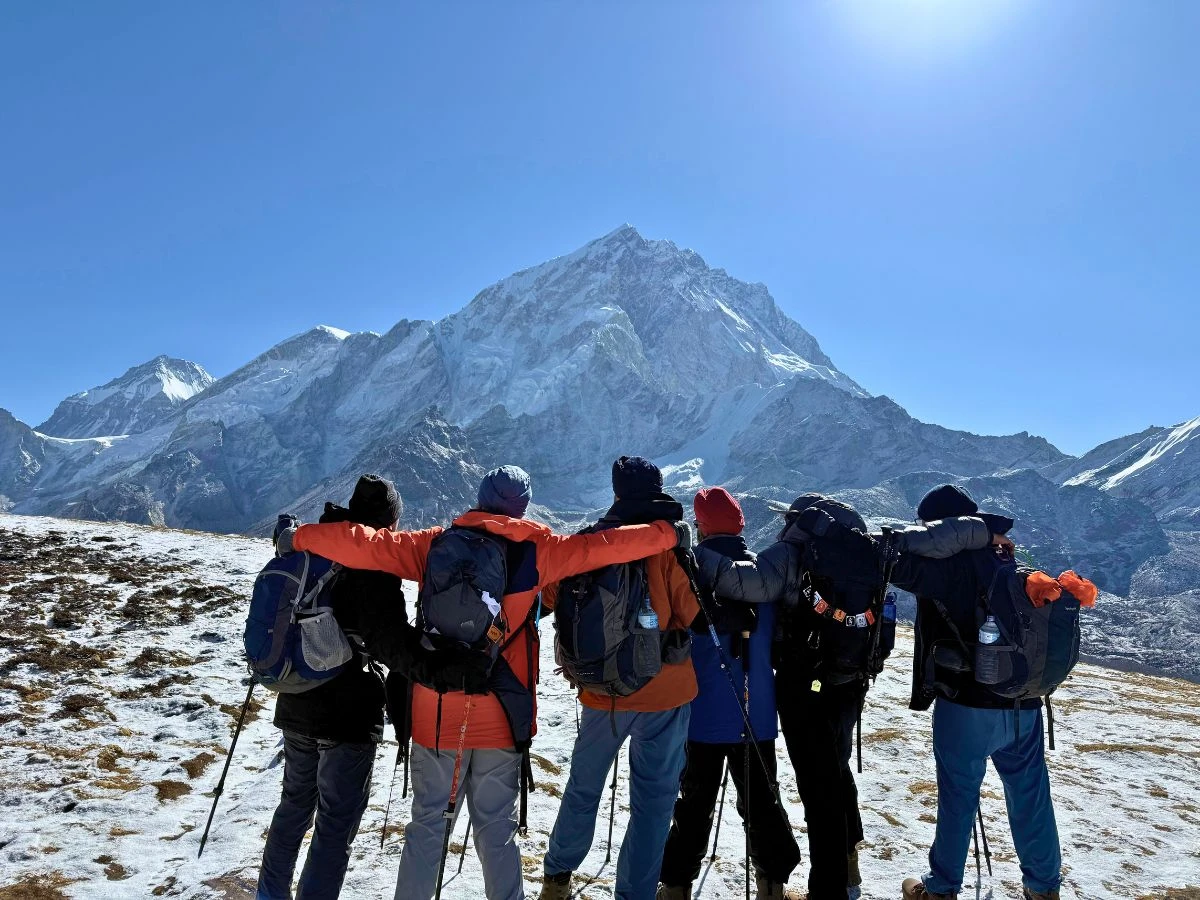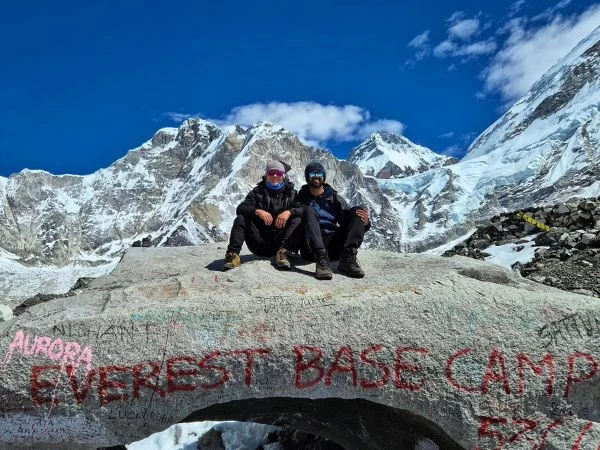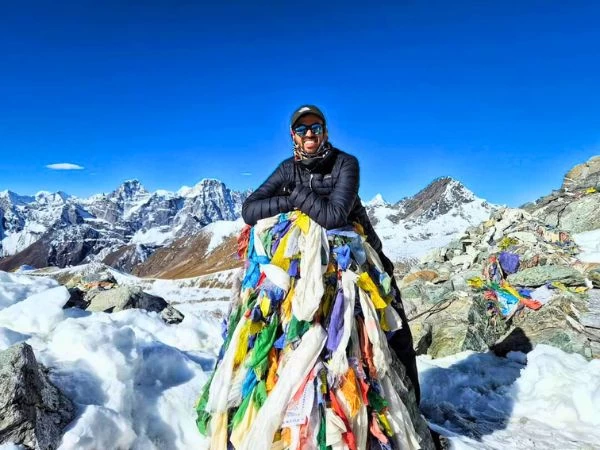Are you interested in joining a group tour to Everest Base Camp? Choosing to trek to Everest Base Camp as part of a group is an excellent option. This trek is a classic Himalayan adventure that allows trekkers to experience the beauty of the world’s highest peak, Mount Everest (8,848 m), up close. By joining a group trek, solo travelers and small parties can team up with others for a guided experience. This not only helps lower costs but also enhances safety and adds a social dynamic to the journey.
Group Trek To Everest Base Camp- 13 Days
Group Trek to Everest Base Camp Overview
The 13-Day Everest Base Camp Trek (EBC) is another popular itinerary for the Everest Base Camp trek in Nepal. This is the best way to reach the Everest Base Camp at 5,364 meters, the world's highest base camp, and this package offers more choices of daily meals (Breakfast, Lunch, and Dinner excluded) from the local Sherpa restaurant on the route.
The Group Trek to Everest Base Camp package is one of the most iconic treks in the world, and many people have dreamed of reaching Everest Base Camp, located at 5,364 meters, at least once in their lifetime. Naturally, this journey takes you through amazing landscapes, traditional Sherpa Villages, ancient Buddhist monasteries, and the beautiful surrounding Sagarmatha National Park, home to various wildlife species.
The Everest Base Camp offers an adventurous flight experience to Lukla Airport (Tenzing-Hillary), which is the highest airport in the world. You'll enjoy breathtaking views of Mount Everest, standing at 8,848 meters, the tallest peak on the planet. Joining a group trek to EBC allows you to share this incredible journey with fellow trekkers, making the experience more social and often safer.
Highlights of Group Trek to Everest Base Camp:
- Together trekking to Mount Everest Base Camp at 5,364 m.
- walking to the elevated terrains of Sagarmatha National Park.
- Scenic adventurous mountain flight between Kathmandu and Lukla.
- Explore the rich Sherpa villages and visit ancient Buddhist monasteries.
- Trek with a local Sherpa guide and friendly porter.
- Minimize your daily trekking expenses while trekking with a group.
- Meeting international people and making friends.
- Visit Khumbu Glacier and reach the world's highest peak base camp.
- Climb Kala Patthar (5,545 m) to experience the most breathtaking views of Everest, Lhotse, and Nuptse with many remarkable ones.
Tourist Attractions of the Everest Base Camp Group Trekking
Everest Base Camp:
The World’s highest peak base camp (Mt. Everest is 8,848 meters/29,029 feet), and many people still have a dream of reaching the ultimate goal once in a lifetime at the foot of Everest, with a spectacular backdrop of glaciers and towering peaks.
Sherpa Culture and Hospitality:
While you have an opportunity to Group Trek to Everest Base Camp, you’ll get the best time to search and experience the warmth of the Sherpa people with their cultural heritage and spiritual life, who have made the region famous for their mountaineering achievements.
Breathtaking Views of Everest and the Himalayas:
The main attraction for both international and domestic tourists on the Everest Base Camp trek is the incredible scenery from various viewpoints along the route. Hikers can enjoy stunning views of Everest (8,848 m), Lhotse, Nuptse, Makalu, and many other impressive snow-peaks.
Sagarmatha National Park:
You're trekking to Mount Everest Base Camp trail through Nepal’s beautiful National Park, a UNESCO World Heritage Site, which is home to diverse flora, fauna, and wild animals.
Historic Tengboche Monastery:
You’ll get the best opportunities to visit one of the oldest and most important monasteries in the Khumbu Everest trekking region, offering spiritual solace and panoramic mountain views.
Why Choose A Group Trek for Everest Base Camp?
Cost-Effective:
This is another beauty of EBC trekking for those who love to do the Everest Base Camp group treks. They are typically more affordable than individual treks, as the cost of guide, porters, accommodation, and logistics is split among participants.
Flexible for Food Choice & Payment:
The Everest Base Camp Trek is a high-altitude trail in the Everest region, Nepal. Along the journey, every trekker does not have the same appetite in the group; some can eat more, and some can eat fewer meals. While you plan the Group Trek to Everest Base Camp with Nepal Spirit Adventure, you’ll get more flexible choices to order meals as per your appetite, which is a beauty of the Everest Base Camp Trekking Package.
Safety Trekking:
You need to know before you plan for the Everest base camp trek that a group trek offers a safety net, especially for novice trekkers. In case of emergencies or high altitude sickness, a group trip has several assistance guides and support.
Shared Experience:
Trekking to Everest Base Camp in a group itinerary allows you to share the experience with different nationalities and cultures, which is a good advantage on a group trek to Mount Everest base camp. Good friendship helps motivate you during challenging sections of the trek.
Trek with Local Experience Guides and Support:
Nepal Spirit Adventure includes a knowledgeable local trek guide and porter support for group trekking to Everest Base Camp, which can make the journey easier and more enriching.
Organized Itinerary:
While you’re trekking to Everest base camp with a group join-based trip, you’ll not get the EBC trek’s itinerary flexible because a group trek follows a carefully planned advance itinerary, which ensures proper acclimatization and reduces the risk of high altitude sickness.
Socializing:
Group treks are often a fun way to meet more people from different parts of the world. You'll get a chance to make good friendships for another adventure, which is another highlight of this Group Trek to Everest Base Camp.
Why Is the Everest Base Camp Trek So Popular?
1. The World's Famous Trekking Destination: Mount Everest is the highest peak in the world. Trekking to Everest Base Camp is always a feeling, and it is a bucket-list destination for trekkers and adventure seekers.
2. Achievable for Many: While climbing Everest itself is an extreme challenge, the base camp trek is accessible to anyone with good health and fitness. You don't need technical mountaineering skills.
3. Natural Beauty and Adventure: The trek to Mount Everest Base Camp offers physical challenges and stunning scenery, providing trekkers with an unforgettable experience.
4. Cultural Immersion: The Everest Base Camp trekking region is rich in Sherpa culture, similar to the Tibetan Buddhist lifestyle, and trekkers have the chance to explore traditional villages, old monasteries, and interact with locals along their EBC journey.
5. The Best Photographic and Video Experience from Nepal: The Everest Base Camp Trek is a popular trekking destination in Nepal, renowned for its stunning mountain views, vibrant native villages, national parks, and majestic peaks. This trek is ideal for photographers and videographers seeking exceptional landscapes and memorable moments. Each year, during the peak trekking seasons of March to May and September to December, many tourists embark on this adventure to capture beautiful pictures and videos, creating lasting memories of their experience trekking to Everest.
When Is The Best Season for the Group Trek to Everest Base Camp?
In a year, there are two best seasons for the Group trek to Everest Base Camp: Spring (March to May) and Autumn (September to December). Depending on your Nepal trekking holiday, you can begin the Everest Base Camp trek during either of these two trekking seasons in Nepal for the EBC routes.
Spring (March to May):
This is considered the best time for EBC trekking. The weather is generally clear, and the temperatures are mild, though it can still be chilly at higher altitudes. This is also the season when Everest climbers prepare for their summit bids, so you’ll encounter an exciting atmosphere in the region. Temperatures range from 10°C (50°F) during the day to -10°C (14°F) at night at higher elevations.
Autumn (September to November):
This season offers the best weather conditions for the Everest Base Camp trip, clear skies, and great views, with the added benefit of fewer trekkers than in the spring. Temperatures are similar to spring, ranging from 10°C (50°F) during the day to -10°C (14°F) at night at higher altitudes.
What Is The Cost of the Everest Base Camp Group Trek?
The cost of a group trek to the Everest base camp varies based on the services that you're looking for in the booking; it makes the different prices depend on the service inclusive and does not include what we're organizing in the various packages for the Everest Base Camp Trekking cost. Here’s a Nepal Spirit Adventure breakdown of what you can expect:
1. Our Standard Budget Trek for EBC:
The package starts from ($900), This is a standard Everest Base Camp service trekking it would cover essential services: Knowledge trek guide, one porter for two trekkers (maximum weight 20 – 25 kg), trekking permit, two-night (twin shared room) hotel in Kathmandu, one night before and one night after the trek, ground private transportation for airport arrival and departure, lodge accommodation along the Everest Base Camp Trek, EBC trekking equipment: Sleeping bag, down jacket and duffel bag (return after the trek), both way air-transportation between Kathmandu and Lukla, guide and porter daily wages, food, accommodation, transport, salary, and insurance coverage.
2. Everest Base Camp Full Board Package:
The trip starts from ($1350), This package is inclusive of a full board package trek: Your trek daily meals-Breakfast, Lunch, and dinner 3 times a day, flight between Kathmandu to Lukla, permit, guide, porter, trek equipment, hotel in city, lodge (tea house) accommodation on EBC trek route all comes full board package trek 14 Days Everest Base Camp Trek.
3. Luxury Trek:
This trek package is different from the other one; the trip starts from ($3,000). This typically includes luxury lodges, better quality food, a private trek guide, extra amenities, and a Helicopter flight from Gorakhsep to Lukla.
The Condition Foothill Journey to Mount Everest Base Camp:
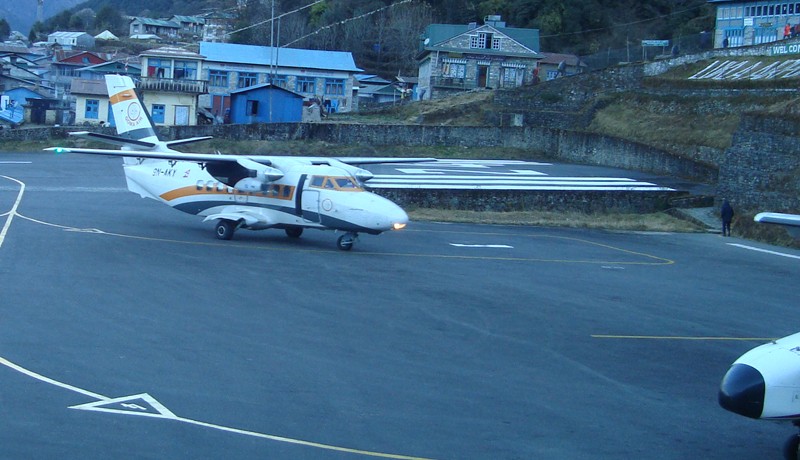
Lukla 2,840 m | 9,317ft, the world’s exciting airport, main gateway to the Everest base camp trek
The flight from Kathmandu to Lukla lasts approximately 35 minutes, followed by a trek to Phakding, situated at an elevation of 2,640 meters, which takes around four hours. Lukla, renowned for its adventurous airport, serves as both the starting and ending point for this journey. After exploring the vibrant city of Kathmandu, travelers can take a flight to Lukla, where a Sherpa guide will lead them through local Sherpa villages, alongside the Dudhkosi River, and into the enchanting forests of Sagarmatha National Park. This trek welcomes all Everest adventurers with its colorful rhododendrons, pines, and fir trees, eventually leading to an arctic temperature zone characterized by barren, icy landscapes. This journey allows for the observation of significant changes in vegetation, climate, and scenery within a brief holiday in Nepal, with the first overnight stay occurring in Phakding, conveniently located near the riverbank.
Trek from Phakding to Namche Bazaar (3,3450 m/11,287feet), approximately between 6-7 hours foothill journey
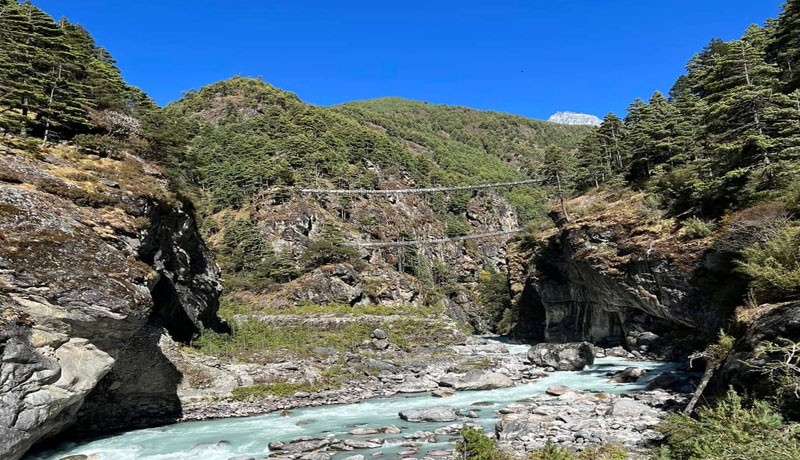
Our Everest base camp trekkers cross Hillary Bridge into the Dudha Koshi River.
Following breakfast, the trek on the second day from Phakding to Namche Bazaar involves a considerable amount of walking hours; however, the surrounding scenery is remarkable, featuring mountains, local villages, Sherpa farms, and numerous high bridges that cross the same river multiple times before reaching Namche Bazaar, where an overnight camping stay is planned. Namche Bazaar serves as a crucial junction for both locals and tourists visiting for various purposes. It is also recognized as the primary gateway to Mount Everest Base Camp, catering to trekking, peak climbing, and Everest expeditions. Notably, every Saturday is a special day when prices are reduced compared to other days, and tourist-level facilities are readily available in Namche Bazaar.
Trekking from Namche to Tenboche 3,867 m/12684 feet, approximately a 6-hour uphill walk, night stop at Dewoche
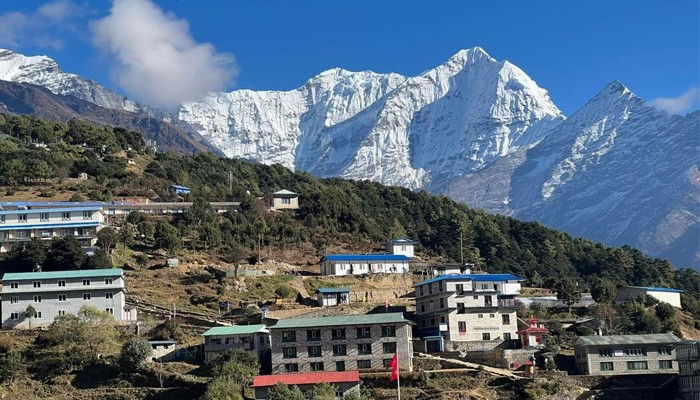
Namche Bazaar 3,440 m | 11,287 feet background view of Mt. Thamresku 6,618 m
Today marks the third day of our trek. During the morning session, we are greeted with stunning views of the surrounding mountains under clear weather conditions. After enjoying breakfast, we will proceed along a scenic, wide path that offers our first glimpse of Everest, Lhotse, Ama Dablam, Kusum Kanguru, and Thamserku, along with their neighboring peaks. The trail ascends through a gentle forest, leading us to a picturesque location at the hilltop of Tengboche. The journey from the banks of the Dudh Kosi River to Tengboche involves a steady ascent, which can be quite physically demanding. Tengboche is home to an ancient Buddhist monastery, renowned throughout the Khumbu Valley as a significant spiritual site, often referred to as a Tibetan monastery.
Trek from Dewoche to Dingboche (4,350 m/14271 feet), approximately 6 hours ascending a high-altitude area
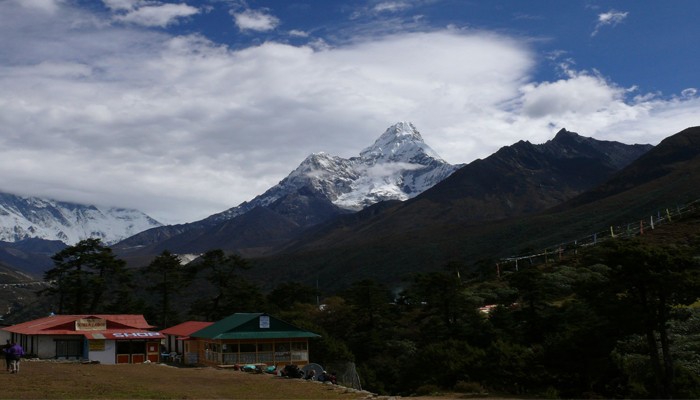
Mt. Ama Dublam 6,814 m view from Tengboche 3,867 m monastery
The four-day trek is not particularly strenuous; however, it does involve ascending into a high-altitude region. We begin our day with breakfast at Dewoche, which provides more comfortable overnight accommodations compared to Tengboche. Our journey continues as we trek through lush greenery and tree lines, leading us into the remote wilderness characterized by arid, windswept terrain. We pass by the villages of Tengboche and Dingboche, all the while enjoying the breathtaking views of the majestic Ama Dablam and Everest. We reach Pangboche and Shomare for a lunch break, where Shomare presents the finest view of Mt. Tawodhe Peak. After crossing the river, we enjoy a flat walk until we arrive at Dingboche, a spacious Sherpa village with agricultural fields and tropical Sherpa settlements. Dingboche is notably warmer than Pheriche.
Acclimatization Day at Dingboche
Before ascending to the high-altitude region, it is advisable to take a day for rest and acclimatization. Today will be dedicated to recuperation, although not solely for sleeping. We will engage in a hike that will enhance your fitness and improve oxygen intake at elevated altitudes. A pleasant 3-4 hour trek to Nangkartshang Gompa, situated on the ridge to the north of Dingboche village, is highly recommended. This location provides a stunning view of Mt. Makalu (8,463 m), the fifth-highest mountain in the world, to the east, along with breathtaking vistas of Mt. Ama Dablam and the valley below. Should we have sufficient energy, we can proceed to the summit of Nangkartshang Hill (5,090 m) for an added sense of adventure. We will then return to Dingboche for our overnight stay.
Trek from Dingboche- Loboche- Gorakshep- Everest Base Camp (5,364 m/17,598feet), re-trek back to Lukla.
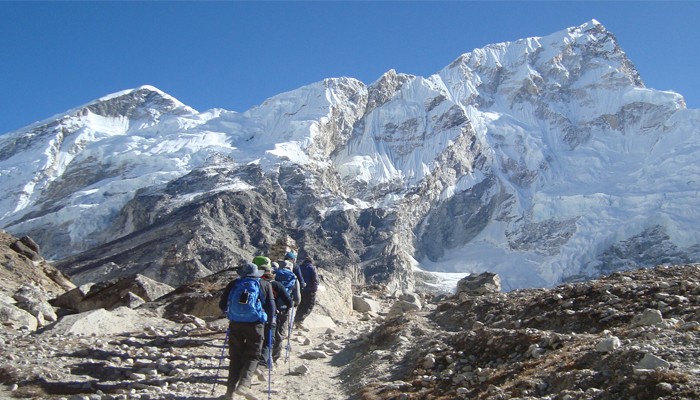
Nepal Spirit Adventure's groups are heading to Mt. Everest Base Camp at 5,364 m.
Following a remarkable acclimatization day in Dingboche, the trek ascends to higher altitudes from this point onward. The initial segment of the journey from Dingboche to Duglha offers a gentle and pleasant environment, showcasing stunning views of the snow-capped mountains. The trek from Duglha to Lobuche becomes more physically demanding as we progress towards our primary objective, the Everest Base Camp, which features the renowned Khumbu Ice Fall. We will spend the night in Lobuche (4,931 m/16,177 feet) and Gorakshep (5,170 m/16,961 feet), both of which serve as high-altitude overnight stops.
The trek from Lobuche to Everest Base Camp constitutes a lengthy day of hiking, requiring approximately seven to eight hours of walking. Upon reaching Mount Everest Base Camp, one can relish a delightful experience before retracing the same path back to Lukla. This journey includes a final ascent to a scenic viewpoint atop Kalapatthar, a rocky hill situated at an elevation of 5,545 meters (18,193 feet), which offers a breathtaking panorama of the surrounding peaks, with Everest prominently in view. The return trek to Lukla spans three days, during which the mountain vistas remain stunning; however, the descent demands considerable physical endurance. These elements are the defining features of the Everest Base Camp Trek.
Why Everest Base Camp Trek with Nepal Spirit Adventure?
- With decades of experience in organizing treks primarily to Everest Base Camp (EBC) in the Nepal Himalayas.
- Group join treks represent one of the most cost-effective options for reaching Everest Base Camp.
- Highly take care of customer service.
- We employ a local trekking guide and porter, ensuring that the majority of the benefits are directed towards the local community.
- All of our scheduled online departure dates are assured to proceed with the trip.
- A small group is coordinating a trek to the base camp of Mt. Everest.
- Embarking on a trek to Everest Base Camp allows you to manage your daily wage expenses while maintaining control over your privacy.
- Convenient online travel reservations and secure payments via Visa and MasterCard, all without any additional charges.
- We offer premium trekking gear, including down jackets, sleeping bags, and duffel bags.
- Free airport transport service (Airport to hotel to airport).
Conclusion:
We have been organizing group treks to Everest Base Camp for decades. A group trek to Everest Base Camp promises an unforgettable adventure filled with breathtaking views, cultural experiences, and camaraderie. This trek is relatively accessible for those with good fitness levels and determination, and the support of fellow trekkers can enhance the experience even further. While significant preparation is required, the rewards are immense, making it one of the most popular trekking destinations in the world. If you’re ready for the challenge, this trek will be an experience you won’t forget!
Trip Gallery
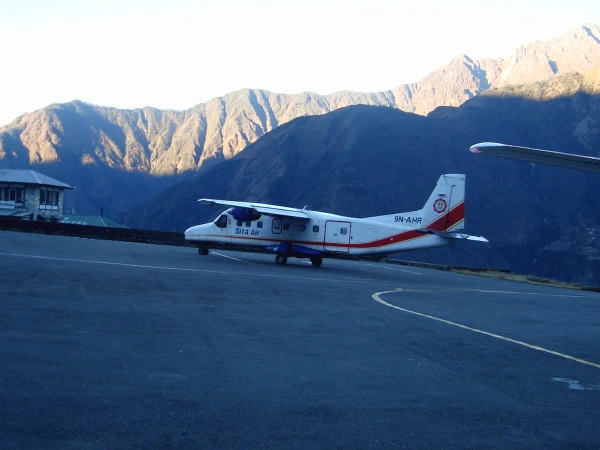
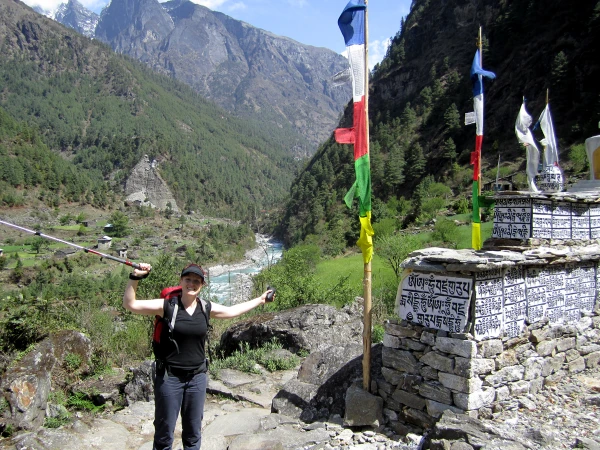

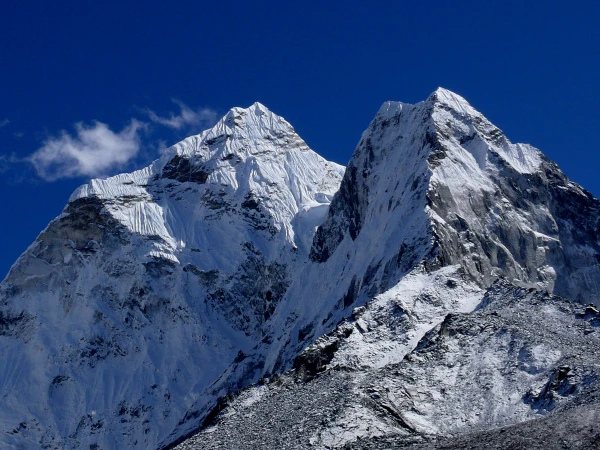
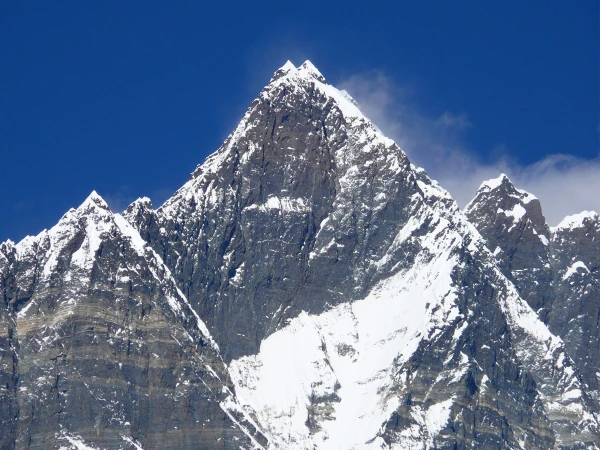


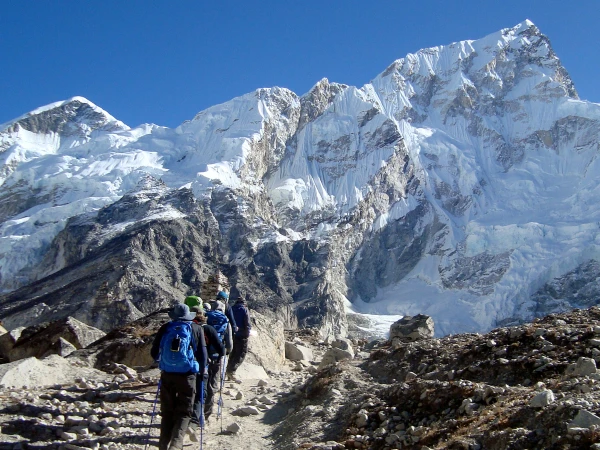

Short Itinerary
Arrival in Kathmandu, Airport Pickup Transfer to Hotel
Flight to Lukla, Trek to Phakding 4hrs
Approx. 7 Hour Trek to Namche Bazaar from Phakding
Acclimatization Day, Hike to Syanboche (3,880 m), 3 hrs.
Approx. 6 Hour Trek to Tengboche from Namche Bazaar
Trek to Dingboche from Tengboche approx. 6hrs
Acclimatization Day, Nangkartshang Hill Hike
Trek from Dingboche to Lobuche 6 hour Approx.
Approximately 7-8hrsTrek to EBC (5,364m) back to Gorakshep
Climb to Kalapatthar (5,545 m) trek to Pheriche 6 hrs
Approx. 7hrs Trek back to Namche Bazaar from Pheriche
Trek from Namche to Lukla
Fly to Kathmandu/Ramechhap- Transfer to Hotel
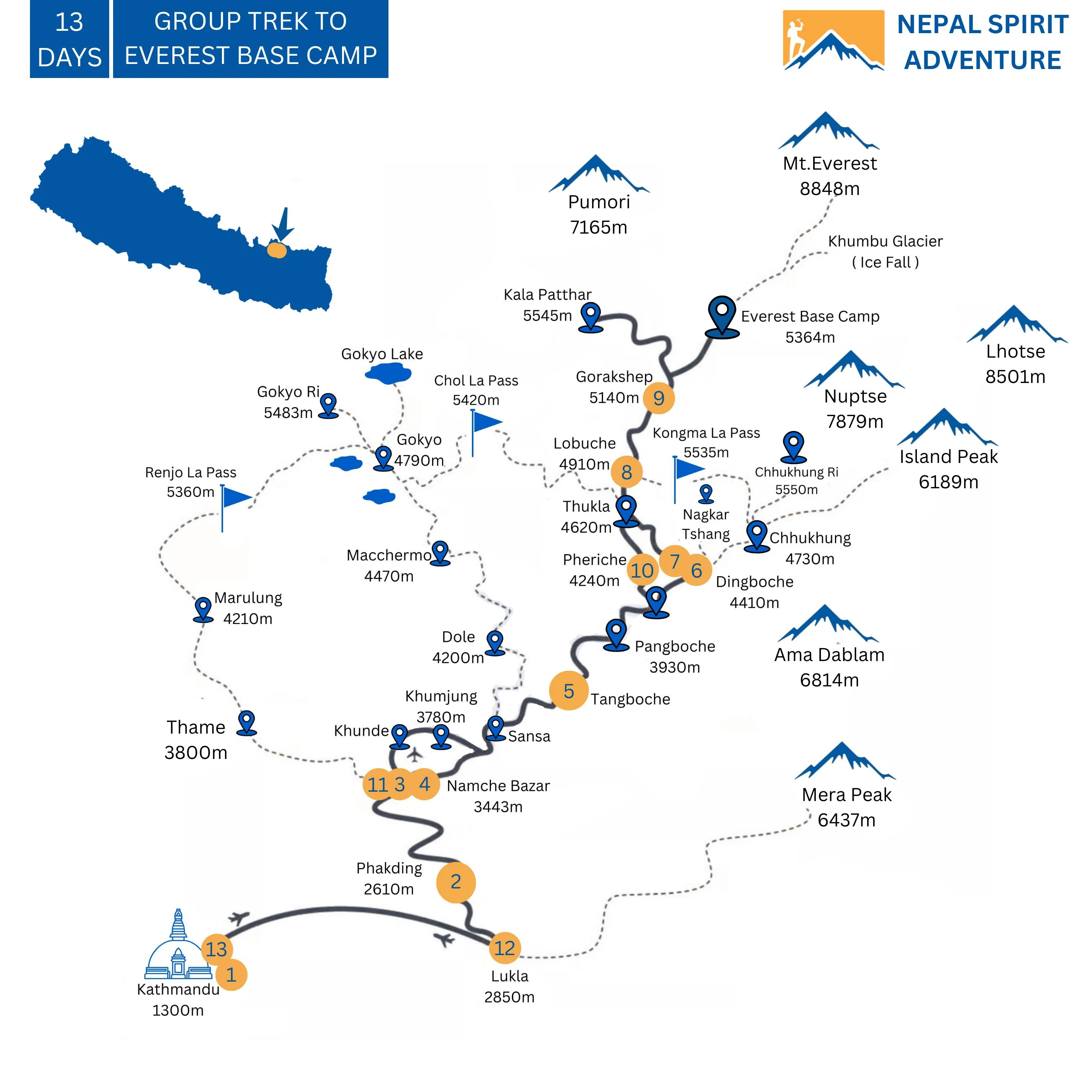
Group Trek To Everest Base Camp- 13 Days Itinerary
The 10-night, 11-day Everest Base Camp trek from Kathmandu to Kathmandu is an ideal choice for experienced, fast trekkers. This flexible itinerary can be customized to suit your travel needs. For more details, please contact Nepal Spirit Adventure.
Arrival in Kathmandu, Airport Pickup Transfer to Hotel
Upon your arrival at Kathmandu's Tribhuvan International Airport, you will be greeted by our assistant and then transferred to a hotel, where you will meet the trek leader and other participants. The trek leader will go over the equipment with you and answer any questions you may have about the high-altitude adventure. If you would like to store extra bags that will not be used during the trek, you can store them at the hotel (free of cost for luggage storage) overnight at the Thamel Park Hotel.
Standard service includes airport pick-up and a hotel in Kathmandu.
Flight to Lukla, Trek to Phakding 4hrs
According to the Kathmandu-Lukla flight schedule, your trek guide-leader will pick you up from your hotel and escort you to the domestic airport for the scenic trans-Himalayan flight. The flight concludes with a spectacular landing on the hillside at Lukla, the gateway to the Everest region. The flight from Kathmandu to Lukla takes about 35 minutes, offering breathtaking views of the Himalayan landscape.
Upon arrival, you will meet other staff who will assist with your duffel bag before beginning the trek downhill to the Sherpa town of Cheung. The trail then follows the edge of the Dudh Koshi Valley before ascending to Ghat (2,530 m). From there, it takes another easy hour to reach Phakding, where you will spend the night in a teahouse by the river.
Kathmandu to Lukla Flight Note:
During the main trekking seasons of April to May and October to November, Lukla flights are often diverted to Manthali (Ramechhap) Airport, located approximately 126 km from Kathmandu. The company arranges overland bus transportation from Kathmandu to Ramechhap, which takes around 4 hours. Private transportation is also available at an additional cost. The flight from Manthali to Lukla takes approximately 12 minutes.
Approx. 7 Hour Trek to Namche Bazaar from Phakding
After breakfast at Hotel Pine Forest, we begin Day 2 with a trek from Phakding to Namche Bazaar. The journey takes approximately six to seven hours of walking. The trail winds through pine forests and follows the Dudh Koshi River, crossing suspension bridges and passing through Sherpa villages such as Benkar, Chumoa, Monjo, and Jorsale—the entrance to Sagarmatha National Park and the permit checkpoint. Along the way, you’ll enjoy tranquil views of the glistening Thamserku (6,618 m / 21,714 ft).
The trail continues along the riverbed to the confluence of the Bhote and Dudh Koshi Rivers before climbing steadily to cross the impressive Tenzing-Hillary suspension bridge. Here, you will catch inspiring glimpses of Everest and the Nuptse–Lhotse ridge. A final three-hour ascent through the pine forest brings you to Namche Bazaar, a thriving trading and administrative town that serves as the gateway to the Khumbu-Everest region.
Acclimatization Day, Hike to Syanboche (3,880 m), 3 hrs.
At Namche Bazaar, you will have a rest day to aid acclimatization at this altitude of over 3,000 meters. On this day, take a short hike to the Everest View Hotel, located above Namche Bazaar. It is the first Porsche hotel or resort in the Khumbu region. The hotel offers spectacular views of Everest, Ama Dablam, and other surrounding peaks, all set against a beautiful backdrop of tall rhododendrons and silver fir trees.
Alternatively, you can take a walk higher above Namche to the Park Museum area, which provides breathtaking views of Everest, Lhotse, and the stunning Ama Dablam peaks. There is also time to visit the museum, which offers fascinating insights into the Khumbu region, including its Sherpa culture and history.
Approx. 6 Hour Trek to Tengboche from Namche Bazaar
From Namche, the morning begins with a short, steep climb that leads to a gradual, scenic trail. This winding path offers glorious views of Everest alongside the magnificent Ama Dablam, all set within the cool shade of woodland. As the walk continues downhill, you reach a bridge over the Imjatse River, leading to a small settlement at Phunge-Tenga, nestled in the forest—an ideal spot for a possible lunch break.
In the afternoon, the walk ascends into the cool, shaded forest filled with quaint woodlands of rhododendron, pine, and fir trees, eventually reaching a small plateau at Tengboche. Here, you are rewarded with an amazing panoramic view of the mountains, including Everest.
At Tengboche, visit the colorful and impressive monastery, where you can witness priests, lamas, and monks engaged in prayer amid the grand surroundings of tall trees and towering peaks. Tengboche is a scenic and beautiful place, known for its annual festival called Mani Rimdu, held in mid-October or November. During this vibrant event, monks don masks representing various deities and perform rituals to ward off evil spirits, a ceremony that continues overnight at the lodge.
Trek to Dingboche from Tengboche approx. 6hrs
In the morning, enjoy views of Everest and the magnificent Ama Dablam. The walk then descends for a few hours to a bridge over the Imjatse River. After crossing the bridge, the trail leads through open country where the tree line disappears, giving way to sparse vegetation and juniper bushes. Continuing with a gentle uphill walk, you will reach Pangboche village at 3,900 meters.
This is the last permanent village before Dingboche and the higher regions beyond. From Pangboche, a slow climb takes you to Somara for lunch. Afterward, the walk continues over pleasant terrain with a final ascent to Dingboche village, where you will spend the night. Situated in the Imjatse Valley, Dingboche offers a picturesque panorama of snow-capped mountains, including the north face of Ama Dablam.
Acclimatization Day, Nangkartshang Hill Hike
The second important rest-acclimatization day at Dingboche (main Sherpa village) is to allow better acclimatization and ensure that every member of the group is healthy and fit for the onward journey to Everest Base Camp.
Everest Base Camp Trek’s guide takes you on a short hike to Nangkartshang Peak, which is approximately 5,083 meters high. From the top of this peak, you can see a spectacular panorama of the Imjatse valley, including Island Peak, Taboche Peaks, and Mount Makalu (the world’s fifth-highest mountain). Making it a popular acclimatization hike for trekkers heading to Everest Base Camp
Trek from Dingboche to Lobuche 6 hour Approx.
Approximately 7-8hrsTrek to EBC (5,364m) back to Gorakshep
After a pleasant stop at Lobuche, the walk continues toward the main highlight of the journey: reaching the much-awaited Everest Base Camp. The morning trek follows a pleasant path, followed by a short climb to higher ground. Then, the trail leads to the Glass Pyramid, a meteorological station established as a joint venture between the Italian and Nepalese governments. This station monitors weather conditions and the movement of ice and glaciers.
From here, with interesting information about the project, the walk continues toward the moraine and ice above Khumbu’s massive glaciers, followed by a short descent to a wide-open field at Gorakshep, a small settlement with a few lodges.
Gorakshep was the original Everest Base Camp before the camp was moved further east. After a brief rest here, the journey resumes by walking across moraine and rocky terrain to finally reach Everest Base Camp, set against the dramatic backdrop of the Khumbu Icefall and glaciers. Everest itself is hidden between the peaks of Lho La and Nuptse, with only the tip visible from the base camp. Throughout, towering peaks surround the area, creating an awe-inspiring view.
After this exciting moment of the adventure, the trek heads back to Gorakshep for the last overnight stay at the highest point of the journey.
Climb to Kalapatthar (5,545 m) trek to Pheriche 6 hrs
Gorakshep is located beneath Kalapathar and the towering peak of Pumori. In the morning, there is a steep climb along a rocky path—an invigorating and breathtaking uphill trek—to reach the summit of Kalapathar, the highest point of the adventure at 5,545 meters. From here, you are rewarded with a sweeping panorama of towering mountains, including close-up views of Pumori and Everest.
After this glorious scenic moment, the descent begins back to Gorakshep, then continues along the same trail toward Lobuche. The trek then reaches Thugla, where the path from Dingboche and Pheriche splits. From here, the trail leads downhill into the flat, windy valley of Pheriche.
After about an hour’s walk through the scenic valley, you arrive at Pheriche—a settlement with several good lodges offering stunning views of Ama Dablam, Taboche, Cholatse, and a series of other peaks. An overnight stop is planned here.
Note: If you choose not to climb Kala Patthar, the trekking distance will be 7.1 miles (11.5 km) and take approximately 5 hours.
Approx. 7hrs Trek back to Namche Bazaar from Pheriche
From Pheriche, the morning trek begins by following the valley to its end, then descending briefly to a river. The path then ascends to a ridge marked by a Stupa, from which a long descent leads past the villages of Somare and Pangboche. After reaching Pangboche, the route involves retracing the ascent back up to Thyangboche, followed by a descent to the Imjatse River. A steep climb then brings you to the villages of Lobesa and Shanasa, before an easy walk takes you to the picturesque town of Kyanjima.
The journey continues toward Namche Bazaar, offering breathtaking views of Everest, Lhotse, Nuptse, and Ama Dablam, along with a stunning array of surrounding peaks. Certain sections of the trail also provide opportunities to spot wildlife, such as Musk Deer and herds of Himalayan Thar, as well as the vibrant Danphe (Lophophorus impejanus), the national bird of Nepal. The trek concludes with an overnight stay at Namche Bazaar after a day filled with scenic walking from Pheriche.
Trek from Namche to Lukla
Today marks the final day of our walking adventure. We will start with a morning stroll along a beautiful trail that winds beside the Dudh Kosi River, leading us to the village of Phakding. From there, we will continue toward the small settlements of Ghat and Tade-Kosi, culminating in a final ascent to the main entrance of Lukla. After this last climb, the remainder of the journey will be relatively easy as we make our way through the town of Lukla and its bustling marketplace, ultimately arriving at our overnight accommodation—a comfortable lodge. We will celebrate this achievement together with our fellow trekkers and the staff.
Fly to Kathmandu/Ramechhap- Transfer to Hotel
Following a scenic morning flight from Lukla to Kathmandu—offering breathtaking views of the mountains during the descent—our staff will assist you with your transfer to your hotel in the Thamel area. The rest of the day is yours to enjoy at your leisure.
Please note: Due to changes in flight schedules, we may need to travel to Kathmandu via Manthali (Ramechhap).
Cost Details
Includes
Accommodation in Kathmandu
- Two nights' hotel accommodation in Kathmandu includes breakfast (twin-share room).
- The hotel is centrally located near the market, restaurant, and some heritage places.
- We provide a private room for a single person (requires paying an extra single room cost).
Transportation
- International airport arrival and departure by private vehicle
- Domestic airport drop-off from your hotel by private vehicle (1 departure transport)
- Domestic airport arrival, transfer to your hotel by private vehicle ( 1 arrival pickup transfer)
- Kathmandu to Lukla to Kathmandu by air ( Jan, Feb, June, July, August, Sept, & Dec)
- Ramechhap to Lukla to Ramechhap by air (October, November, March, April, and May months)
- Kathmandu to Ramechhap to Kathmandu by tourist shared vehicle (if we need a flight from Ramechhap to Lukla to Ramechhap).
Accommodation in Trek Period
- Five nights in a guesthouse include an attached bath-inside toilet, twin share room (Phakding 1 night, Namche 3 nights, and Lukla 1 night).
- Six nights in a teahouse common bathroom, twin share room (Tengboche 1 night, Dingboche 2 nights, Lobuche 1 night, Gorakshep 1 night, and Pheriche 1 night).
Everest Base Camp Group Trek Permit
- Everest Base Camp trek route permit (Sagarmatha National Park Permit).
- Pasang Lhamu rural village development municipality permit.
- TIMS security card for staff and guests.
EBC Trek Field Staff
- Sherpa trek guide, including his daily wages: Food, accommodation, transportation, salary, and insurance
- Porter (1 porter for 2 trekkers), including his daily wages, meals, accommodation, salary, and insurance
- Assistant trek guide (1: 10 people in group), including his daily wages, insurance, food, accommodation, transportation, and salary
Trek Equipment and First Aid
- Nepal Spirit Adventure's duffel/kit bag, EBC trek map, t-shirt, and flesh hat
- Down sleeping bag
- Down jacket
- Note: Sleeping bag, down jacket, and duffel bag (to be returned after the trek)
- General first aid kit, including an Oximeter to check pulse and oxygen levels daily on the trek
- Everest Base Camp trek completion certificate
24 Hours Helpline Support
- Easy with question/answer before trip booking
- Every day, call a meeting with the trek guide (To know the condition of guests and staff)
- Arrangement of emergency helicopter rescue ( it may be required)
Excludes
- Your international airfare to Kathamndu
- Nepal visa fee
- Everest Base Camp Trek Daily Meals
- Personal trekking equipment
- Daily food on trek and Kathmandu (approximately $23-25$ per day)
- For travel and trek insurance, it is better to bring the insurance policy above 4000m
- Personal medicine kit
- Private transportation to Manthali-Ramechhap, if we need the flight to Lukla from Manthali
- Tipping
Dates & Availability
Private TripOne-line trek departure date is the trip guaranteed to be organized. The departure date does not match your Nepal holiday plan. Email us with your EBC trek start date, and we're more than happy to open a new departure date for you. We organize private trips at any time of the year.
Essential Information
Free Arrival Pickup and Departure Transportation From the Kathmandu Airport
We’re delighted to provide complimentary transportation from the Tribhuvan International Airport of Kathmandu for trekkers who have made a reservation for a group trek to Mount Everest base camp with our company. Upon your arrival, a representative from Nepal Spirit Adventure will be waiting for you at the airport, holding a pamphlet displaying your name. He will then escort you to your hotel in a private vehicle. We provide this service to ensure you don’t face any difficulties in a foreign country.
Is The Group Trek to Everest Base Camp Fit For Me?
The trek is suitable for individuals with a good level of physical fitness and a sense of adventure. While it is a high-altitude physical trek, it is accessible to a wide range of people who are willing to prepare themselves physically and mentally for this category of adventure in the Nepal Himalayas.
It is a group-based trek, and you will meet people from different countries joining a group to the Everest base camp on the same trip departure date, starting and ending in Kathmandu. At Nepal Spirit Adventure, we organize 13-day itineraries tailored to fitness levels and preferences. Whether you are an experienced trekker seeking a challenging adventure or a first-time trekker with a sense of adventure, we can provide guidance and support to help you make the most of your Everest Base Camp Trek.
Is Kathmandu Hotel Included in the EBC Trek?
The accommodation in Kathmandu includes a package for two nights in a twin shared room at a three-star hotel, including breakfast. This arrangement covers one night before the trek and one night following the Everest Base Camp trek. The hotel is situated in the prime area of Thamel, providing convenient access to the main shopping and dining establishments.
What Types of Lodge Accommodations Are Offered in the Package?
We offer the finest and most hygienic twin-sharing accommodations in the guesthouse (lodge/teahouse) for individuals of the same gender along the trekking route. To enhance your comfort, we provide rooms with attached bathrooms, featuring both cold and hot showers at select locations, including Phakding (one night), Namche (three nights), and Lukla (one night). This additional service will enhance your experience during the Group Trek to Everest Base Camp, as well as at other destinations such as Tengboche, Dingboche, Lobuche, and Gorakshep, where you will find standard lodges with shared bathroom facilities.
Is The Equipment Provided for the Group Trek to Everest Base Camp?
Thank you for a very good question, which is important for the Group Trekking to Everest Base Camp. We provide a sleeping bag, down jacket, and duffel bag (returnable after the EBC trip). The personal EBC trekking equipment is not included in the trip package; you need to bring it from your home country, or if you do not have all, you can buy it in Kathmandu after you arrive. If your international flight is arriving in Kathmandu, Nepal, late at night, you should inform Nepal Spirit Adventure about your down jacket size.
Is Trek a Requirement For the Everest Base Camp Group Trek and Cost?
For the group trekking to Everest Base Camp, the hiking permit is a requirement, called the Sagarmatha National Park Permit. You need another local TREK CARD called Khumbu Pasanglhamu Rural Municipality. Both trekking permits cost 45 dollars per EBC trekker. This permit cost is included in the trip package of the group trek to Everest Base Camp. Without those permits, we can not complete the EBC trip in Nepal.
What Kind of Food Is Available & What Is the Cost for the Everest Base Camp Trek?
Food is very important for every Everest Base Camp trekker. Along the route, you'll find both domestic and international meals from the teahouses. These establishments offer basic and hearty meals, with a focus on local dishes such as Dal Bhat (lentil soup with rice), Momo (dumplings), pasta, and fried rice. You can also find some Western foods like pizza, pancakes, and spaghetti, along with a variety of soups.
Regarding the food system on the trek, breakfast and dinner are compulsory meals that you must eat in the teahouses (lodges) where you will be staying overnight. There will not be alternative dining options at these locations. However, for lunch, you can eat at different local Sherpa restaurants.
Typically, the breakfast menu includes options such as toast with honey, butter, or jam, egg dishes, pancakes with honey, porridge, tea, coffee, and more. On average, you can expect to spend around $22 to 25 USD per day per person for three meals; you can spend more or less depending on your appetite.
What Is the Packaging List for the Group Trek to Everest Base Camp?
Nepal Spirit Adventure provides you with a down sleeping bag jacket and a company duffel bag (return after the trek). The trek to Everest base camp is at a high altitude above 5,364 m, and you need to prepare well with trekking equipment before leaving Kathmandu. We recommend the following trekking equipment: cross-check this list when you are packing. If you do not have them with you from your place, remember that you can hire or buy them at a very reasonable price in Kathmandu after you arrive in Nepal.
Head:
- Sun hat or scarf, or neck gaiter
- Light balaclava or warm fleece hat
- Sunglasses with UV protection
Upper Body:
- T-shirts
- Light and expedition-weight thermal tops
- Fleece jacket or pullover
- Fleece Wind-Stopper jacket (optional)
- Waterproof (preferably breathable fabric) shell jacket
- Down vest or jacket
Lower Body:
- Under Garments
- Hiking shorts
- Lightweight cotton long pants
- Light and expedition-weight thermal bottoms
- Fleece or wool pants (seasonal)
- Waterproof (preferably breathable fabric) shell pants
Feet:
- Thin, lightweight inner socks
- Thick, warm wool hiking socks
- Hiking boots with spare laces
- Camp shoes (sneakers and/or sandals), Gaiters for hiking in winter to the base camp
Hands:
- Lightweight gloves
- Heavyweight gloves or mittens with a waterproof shell outer (seasonal)
Accessories:
- Sleeping bag rated to zero DC * Supplied
- Headlamp (e.g., Petzl Zoom) with spare bulbs and batteries
- Trekking Bags/Duffel bag
- Basic First Aid Kit
- Large plastic bags - for keeping items dry inside the trek bag
- Daypack (approximately 2500 to 3000 cubic inches)
- Trekking Poles
- Water bottle (2) or camel bag
- Toiletries (Small wash towel, Toilet paper in a plastic bag, etc.)
- Ear Plugs (who knows, some people in the group are snoring)
Personal:
- Lip Guard
- Passport copies
- Flashlight
Toiletries:
- 1 medium-sized quick-drying towel
- Toothbrush/paste (preferably biodegradable)
- Multipurpose soap (preferably biodegradable)
- Aquatabs
- Deodorants
- Nail clippers
- Face and body moisturizer
- Feminine hygiene products
- Small mirror
- Suncream or Zinc Sun protection
-
Personal Hygiene:
- Wet wipes (baby wipes)
- Tissue /toilet roll
- Bacterial hand wash
Extras/Luxuries:
- Camera, spare batteries, and or Binoculars
- Reading book
- Trail Map/Guidebook
- Journal & Pen
What do you carry for the trek?
Please, bring the equipment listed above and pack your gear for the trek into a duffel bag or rucksacks, and a small day bag for you. The larger bag with your kit will be carried by the porter to meet you each evening. You should bring a day pack to carry by yourself for water, a rain jacket, a hat, gloves, money, etc. The weather in the mountains is changeable, so you will need some warm clothes with you in your day pack.
Can I get a Nepal visa upon arrival? How much will it cost?
Of course, you can receive a Nepal visa after you arrive at Tribhuvan International Airport at the visa section. If you are arriving in Nepal through overland services from the Chinese border, you can get a Nepal visa from either border. There is an immigration process for a Nepal visa. You can also apply for the online visa through Nepal Visa Service.
Arrival visa:
Upon arrival at Tribhuvan International Airport in Kathmandu or other entry points, you can fill out a visa application form available at the airport. You will need to provide a valid passport, a recent passport-sized photograph, and the visa fee in the form of cash (preferably in USD) or a credit card.
What Is the Cost of a Nepal Visa?
- 15 days: USD 30
- 30 days: USD 50
- 90 days: USD 125
What is The Best Season for A Group Trek to Everest Base Camp?
The ideal seasons to plan the Everest Base Camp Trek in Nepal are spring (March to May) and autumn (October to November/December). These seasons offer the most favorable weather conditions, excellent visibility, and well-maintained trails, ensuring a safe and enjoyable trekking experience.
IS Travel and Trekking Insurance Required for This Trip?
Travel and trekking insurance are essential for the group trek to the Everest base camp. Trek is a mandatory requirement. When choosing your insurance policy, ensure that it covers the following key aspects: trip cancellation or interruption, medical evacuation (including treatment costs, hospital charges, doctor's fees, and medication expenses), flight insurance (for cancellations and delays), and baggage insurance (in case of misplaced or lost luggage). You may also consider adding supplemental policies to cover specific issues such as identity theft, security, and political evacuations (related to natural disasters, civil unrest, political instability, etc.).
Alternatively, you can opt for a comprehensive insurance policy that covers all the aforementioned aspects, including expenses incurred due to delayed trips, missed flights, or any itinerary changes made by the tour company. It's important to note that the maximum elevation reached during this trek is 5,550 meters. Therefore, ensure that your policy includes helicopter and medical evacuation coverage up to 6,000 meters, as some standard policies only cover up to 4,000 meters. Prioritize obtaining comprehensive trekking and travel insurance to safeguard yourself against unforeseen circumstances and ensure peace of mind throughout your Everest Base Camp Trek.
What Happens If I Get Sick or Injured During the Everest Base Camp Trek?
Your safety is our utmost priority. We ensure that your trek is conducted by highly professional, experienced, licensed guides who are also trained in First Aid. Should you experience any illness or injury, our guides are equipped to administer essential first-aid care, and in critical circumstances. The natural treatment will be a 500 to 1000-meter descending trek from the event point of the high-altitude sickness. While your trek descending from high altitude to low altitude is still not working for your body, we'll arrange for a rescue helicopter to transport you back to Kathmandu for additional medical assistance.
Why Should I Book My Everest Base Camp Trek with Nepal Spirit Adventure?
Although Nepal Spirit Adventure provides services like any other trekking company in Nepal, there are still a few things that make us stand out in the crowd. Highly dedicated to perfection and superior service, we offer years of experience to plan an outstanding adventure trip for you. Our partnership with local people will help you explore those areas, cultures, and traditions in the Khumbu region that have seldom been explored before. We cater to every possible need of yours, during your stay in Nepal, be it food, accommodation, varied destinations, or communication needs. If our standard packages meet your requirements, we offer an option to fully customize the trip to meet the needs and requirements of each traveler. Our best packages are available at the most competitive rates in the market.
Moreover, registered under the government of Nepal, Nepal Spirit Adventure is fully licensed and certified to organize adventure trips like trekking, hiking, expeditions, tours, and other tourism-related services in Nepal, Bhutan, and Tibet. We believe in and practice responsible tourism. In addition to this, we are also a very active member of the following organizations:
- Nepal Tourism Board (NTB)
- Trekking Agents Association of Nepal (TAAN)
- Ministry of Finance, Department of Taxation
- Company Registration Office, Pvt. Ltd.
- Ministry of Tourism and Civil Aviation, Department of Tourism Industry
Equipments
Recommendation EBC trek equipment packing list
Head:
- Sun hat or scarf, or neck gaiter
- Light balaclava or warm fleece hat
- Sunglasses with UV protection
Upper Body:
- T-shirts
- Light and expedition-weight thermal tops
- Fleece jacket or pullover
- Fleece Wind-Stopper jacket (optional)
- Waterproof (preferably breathable fabric) shell jacket
- Down vest or jacket
Lower Body:
- Under Garments
- Hiking shorts
- Lightweight cotton long pants
- Light and expedition-weight thermal bottoms
- Fleece or wool pants (seasonal)
- Waterproof (preferably breathable fabric) shell pants
Feet:
- Thin, lightweight inner socks
- Thick, warm wool hiking socks
- Hiking boots with spare laces
- Camp shoes (sneakers and/or sandals), Gaiters for hiking in winter to the base camp
Hands:
- Lightweight gloves
- Heavyweight gloves or mittens with a waterproof shell outer (seasonal)
Accessories:
- Sleeping bag rated to zero DC * Supplied
- Headlamp (e.g., Petzl Zoom) with spare bulbs and batteries
- Trekking Bags/Duffel bag
- Basic First Aid Kit
- Large plastic bags - for keeping items dry inside the trek bag
- Daypack (approximately 2500 to 3000 cubic inches)
- Trekking Poles
- Water bottle (2) or camel bag
- Toiletries (Small wash towel, Toilet paper in a plastic bag, etc.)
- Ear Plugs (who knows, some people in the group are snoring)
Personal:
- Lip Guard
- Passport copies
- Flashlight
Toiletries:
- 1 medium-sized quick-drying towel
- Toothbrush/paste (preferably biodegradable)
- Multipurpose soap (preferably biodegradable)
- Aquatabs
- Deodorants
- Nail clippers
- Face and body moisturizer
- Feminine hygiene products
- Small mirror
- Suncream or Zinc Sun protection
Personal Hygiene:
- Personal Hygiene:
- Wet wipes (baby wipes)
- Tissue /toilet roll
- Bacterial hand wash
Extras/Luxuries:
- Camera, spare batteries, and or Binoculars
- Reading book
- Trail Map/Guidebook
- Journal & Pen
What do you carry for the trek?
Please, bring the equipment listed above and pack your gear for the trek into a duffel bag or rucksacks, and a small day bag for you. The larger bag with your kit will be carried by the porter to meet you each evening. You should bring a day pack to carry by yourself for water, a rain jacket, a hat, gloves, money, etc. The weather in the mountains is changeable, so you will need some warm clothes with you in your day pack.
What Our Guests Say?
I am grateful to Nepal Spirit Adventure. Your work was excellent. It was my life's great adventure. Despite the difficulty of the Everest Base Camp Trek, the people and mountain vistas were breathtaking. It's a journey I will always remember...
Thank you so much, Ram. You made our EBC journey incredible. Nepal Spirit Adventure had an outstanding trek guide and porter. Tony was a great guide, and Anuj and the other staff were excellent. Without them, we could not even think...
Members of the group came from Brazil, India, and the United States. We were quite fortunate to have reserved this excursion with the Nepal Base High Range Company, even though the journey was undoubtedly difficult. The proprietor of the business,...
